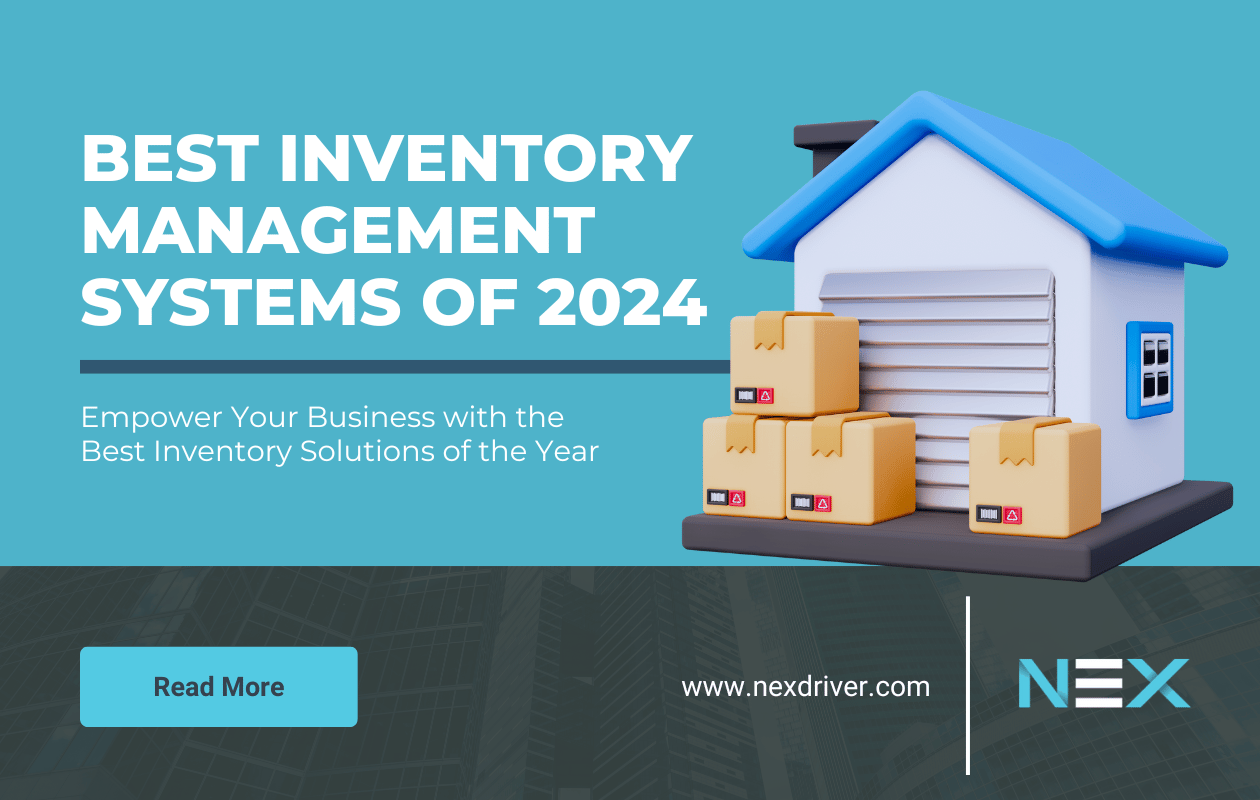1 min read
10 Best Inventory Management Software Solutions of 2024
For small to medium-sized businesses, effectively managing inventory is crucial for operational efficiency and profitability. Navigating the complex...
9 min read
NEX Marketing : Apr 18, 2024 1:46:27 PM
Inventory management is a critical component for any business dealing with goods and products. As we approach 2024, the significance of inventory management software is increasingly apparent, with its market value projected to reach $2,191.2 million. This highlights its indispensable role in contemporary business operations. Inventory management transcends mere stock tracking; it requires strategic planning based on analyzing past sales data and market trends. This process helps businesses achieve the ideal balance between having too much and too little inventory, optimizing costs, and enhancing customer satisfaction. This blog tackles the strategic approach and how it is essential for maintaining operational efficiency and ensuring the business can respond adeptly to fluctuating market demands.
TL;DR: Inventory management is crucial for sustaining efficient business operations, ensuring that stock levels are optimal to avoid both overstocking and shortages. This balance is essential for reducing costs and maximizing product availability. Modern inventory management integrates technologies such as RFID and cloud-based systems, enabling real-time tracking of inventory. This capability allows businesses to respond swiftly to changes in demand and supply. Whether it involves basic manual tracking for smaller businesses or sophisticated real-time data analytics for large corporations, effective inventory management is essential for maintaining competitiveness in today's dynamic market environment.
Inventory management is a critical business function that involves managing the ordering, storage, and utilization of materials needed for production, as well as overseeing the stock of finished products. Effective inventory management ensures a company maintains an optimal stock level, avoiding overstocking and shortages, thus reducing costs and maximizing sales by having products available when needed.
This process goes beyond simply tracking inventory quantities and locations. It includes forecasting future demand based on past sales, market trends, and other external factors to plan production and procurement efficiently. This strategic planning helps maintain a balance between excessive and insufficient inventory, preventing capital tie-ups, excessive storage costs, or missed sales and customer dissatisfaction due to unavailability of products.
Inventory management practices vary by company size and supply chain complexity. Small businesses may use manual tracking or basic software, while larger companies might need advanced systems that integrate real-time data and analytics across various locations for better forecasting and replenishment.
Today's inventory management systems are typically part of broader supply chain management systems, incorporating order management, procurement, logistics, and sales. These systems utilize technologies like barcode scanners, RFID tags, and cloud-based software to provide real-time inventory tracking, enabling companies to quickly adjust to demand and supply changes.
Inventory management is vital for effective business operations, helping maintain customer satisfaction, optimize costs, and support a strong financial performance. Whether through basic tools or sophisticated technology, robust inventory management is key to staying competitive in the dynamic market landscape.
Effective inventory management is crucial for several key reasons that significantly impact the success and sustainability of a company.
An effective inventory management minimizes costs related to excess inventory. Overstocking can be costly due to storage fees and depreciation of unsold items. It also ties up capital that could be better utilized in other business areas like expansion or marketing. Efficient inventory management helps businesses maintain optimal stock levels to meet demand without overusing resources.
Inventory management directly affects customer satisfaction and retention. Adequately stocking items to meet demand fluctuations without experiencing shortages is vital. Frequent stockouts can drive customers to competitors who can meet their needs. Effective inventory control ensures products are available when needed, enhancing customer experience and fostering loyalty.
Furthermore, proper inventory systems streamline operations and increase efficiency. These systems track products throughout the supply chain, reducing time spent locating items and preparing them for shipment. This increased efficiency leads to quicker delivery times, lowers labor costs, and minimizes errors associated with manual tracking.
Effective inventory management provides valuable data and insights. Companies can use data analysis to predict trends, understand customer preferences, and make informed decisions about product lines and marketing strategies. This information is crucial for maintaining a competitive edge and quickly adapting to market changes.
Lastly, robust inventory management is essential for compliance and accurate reporting. Precise inventory records are necessary for financial reporting, tax assessments, and meeting regulatory standards. Discrepancies can result in severe legal and financial issues. Accurate and up-to-date inventory records ensure compliance with laws and regulations, which is fundamental to a company's operational legitimacy and financial health.
The four main types of inventory are crucial for businesses to manage in order to streamline operations and enhance efficiency. Each category represents a different stage in the production or sales process and necessitates specific management strategies. Knowing these types helps businesses optimize inventory control and ensure the availability of the right products when needed.
Raw Materials: These are the fundamental components used in the manufacturing of goods. Managing raw materials inventory involves maintaining enough stock to meet production demands without overstocking, which can tie up capital and increase storage costs. Effective management of this type ensures that production runs smoothly without interruptions due to shortages.
Work-in-Progress (WIP): This inventory includes items currently in production but not yet finished. WIP inventory management is complex as it requires tracking the progress of goods through various production stages, along with monitoring associated costs such as labor and overheads. Effective management of WIP helps identify production bottlenecks and prevent resource wastage on defective products or inefficient processes.
Finished Goods: These are products that are complete and ready to be sold to customers. Managing finished goods inventory is critical for meeting customer demand and avoiding overstock. This type of inventory is closely linked to sales and customer satisfaction, as timely availability of products is essential for market success and competitive advantage.
Maintenance, Repair, and Operations (MRO) Supplies: MRO inventory includes items that support production but are not part of the finished product. These include cleaning supplies, spare parts, and tools, essential for the daily operations of a business. While MRO supplies do not directly generate revenue, they are vital for maintaining production efficiency and ensuring that machinery and equipment function properly.
By effectively managing these four types of inventory, businesses can optimize their operations, reduce costs, and boost profitability. Each type requires tailored strategies and tools, reflecting its specific role in the production and sales cycle. Understanding and implementing these strategies is crucial for operational excellence and achieving business goals.
Exploring various inventory management techniques is crucial for optimizing business operations and effectively meeting customer demands. One prominent method is the Just-In-Time (JIT) system, which minimizes inventory levels by ensuring stock arrives only when needed for production or sales, thus reducing warehousing costs and waste. However, JIT requires accurate planning and robust supplier coordination. Another effective approach is the Economic Order Quantity (EOQ), a formula that determines the optimal order quantity to minimize total costs related to ordering, receiving, and holding inventory. This method is particularly useful for businesses with stable demand and predictable costs.
ABC Analysis is also a strategic approach that categorizes inventory into three classes based on value and importance, allowing companies to focus their management efforts on high-value items. Meanwhile, the Perpetual Inventory System employs software to continuously update inventory records as transactions occur, providing immediate insights into stock levels to avoid shortages and overstock situations.
Inventory valuation methods such as First In, First Out (FIFO) and Last In, First Out (LIFO) also play critical roles. FIFO is ideal for perishable goods, ensuring that older stock is sold first, while LIFO can be advantageous for tax purposes during inflationary periods, as it assumes that the most recently added items are sold first. Additionally, Cycle Counting offers an alternative to year-end physical counts by spreading inventory checks throughout the year based on item classification, which improves record accuracy and minimizes operational disruptions.
By carefully selecting and implementing these techniques, businesses can greatly enhance operational efficiency, reduce costs, and improve service levels, tailoring their inventory management strategies to the specific needs of their products, sales volume, and overall supply chain complexity.
Inventory management systems are crucial for optimizing operations across businesses of all sizes, integrating various functions to enhance efficiency and accuracy in inventory handling, and driving overall business success.
These systems provide essential real-time inventory tracking, automatically updating records as transactions occur. This up-to-the-minute data allows businesses to make swift decisions, such as when to replenish stock or modify sales tactics based on current inventory levels. This capability is critical for maintaining optimal stock levels and responding quickly to market demands.
Additionally, inventory management systems significantly improve order fulfillment efficiency. With accurate inventory data, the time spent on manual counts and searching for stock is reduced, enabling faster responses to customer orders. This efficiency not only accelerates the delivery process but also boosts customer satisfaction by meeting delivery expectations consistently. The systems also automatically alert staff to restock items when levels drop below set thresholds, ensuring adequate inventory to meet customer demand without the risk of overstocking.
These systems also help reduce costs associated with excess inventory and storage by offering detailed insights into inventory turnover rates and sales patterns. Businesses can maintain just enough stock to meet demand, minimizing storage costs and reducing the risk of inventory becoming obsolete.
The ability to integrate with other business systems, such as accounting, CRM, and supply chain management tools, is another significant benefit of inventory management systems. This integration provides a holistic view of operations, streamlining workflows, and enhancing communication across departments, which fosters coordinated and strategic decision-making.
Furthermore, inventory management systems facilitate better reporting and forecasting. They generate detailed reports on inventory trends, sales performance, and customer preferences, crucial for strategic planning. Analyzing historical data and predicting future trends help businesses to adjust inventory levels proactively and avoid potential challenges.
Proper inventory management is essential for enhancing both the operational efficiency and financial health of a business, offering substantial benefits across various company aspects from cost savings to customer satisfaction.
Cost Reductions: Effective inventory management significantly cuts costs associated with excess inventory, such as the need for additional storage space and increased handling costs, insurance premiums, and potential spoilage, especially for perishable goods. By maintaining optimal inventory levels, businesses can reduce these expenses, freeing up capital for other vital areas like expansion or marketing.
Enhanced Cash Flow: Tied closely to cost reductions, improved inventory management also boosts a company's cash flow. By avoiding overstocking, businesses prevent cash from being locked up in unsold stock, ensuring capital is available for other essential operations, including marketing or research and development.
Improved Customer Service: Effective inventory management ensures that the right products are available when customers need them, crucial for customer satisfaction. This reliability fosters customer trust and loyalty, leading to repeat business and a strong customer base, particularly valuable in competitive markets.
Increased Efficiency and Productivity: Proper inventory management optimizes various operational processes like order fulfillment, restocking, and warehousing. Automation and better organization decrease the time and labor needed for inventory tasks, allowing staff to focus on other business areas. This boosts productivity and overall operational efficiency.
Better Data and Insights for Decision Making: Modern inventory management systems provide advanced analytics and reporting tools that offer insights into inventory trends, sales patterns, and customer preferences. This information is vital for informed decision-making regarding product management, promotional strategies, and market expansion. It also aids in more accurate demand forecasting, enabling businesses to adapt swiftly to market changes and capitalize on new opportunities.
Risk Mitigation: Effective inventory management also helps mitigate risks associated with stockouts and excess inventory. It ensures a balanced inventory approach that meets market demands without overextending. Additionally, it enhances regulatory compliance concerning stock levels and safety, reducing the risk of fines and legal challenges.
Proper inventory management is critical not only for streamlining operations but also for improving a business’s financial stance and competitive edge. Its benefits reach beyond simple inventory control, impacting nearly every aspect of a business from financial management and customer relations to strategic planning and compliance.
Determining the right amount of inventory is critical for maintaining operational efficiency and financial health in a business. It's a delicate balance: too much inventory leads to high holding costs and potential waste, while too little can cause missed sales opportunities and customer dissatisfaction. Here are several strategies to help businesses accurately gauge their inventory needs.
Understanding sales patterns and customer demand is essential. Analyzing historical sales data helps identify trends such as seasonal fluctuations and the impact of promotions on inventory levels. This analysis provides a foundation for accurate forecasting. Additionally, businesses should consider external factors like economic conditions, market trends, and competitor activities, which can significantly affect customer demand.
Implementing an inventory management system with demand forecasting capabilities is another vital strategy. These systems utilize algorithms and analytics based on historical sales to predict future demand. By automating the forecasting process, businesses can reduce the guesswork involved in inventory planning. These systems also adapt forecasts based on real-time sales data and external influences, enhancing the accuracy of inventory orders.
The Economic Order Quantity (EOQ) model is a traditional tool used to calculate the optimal order quantity that minimizes the total costs of inventory, including ordering and holding costs. By considering demand rate, setup costs, and storage costs, EOQ provides a quantitative foundation for inventory decisions, helping maintain adequate stock levels to avoid shortages while minimizing costs.
Just-In-Time (JIT) inventory management is an effective approach for businesses aiming to reduce holding costs. JIT involves ordering and receiving goods only as they are needed in the production process, which minimizes the costs of storing unused inventory. This method requires tight coordination with suppliers and accurate demand forecasting to ensure timely delivery of materials.
Regularly reviewing and adjusting inventory levels is also crucial. Business conditions can change due to factors like new product launches, shifts in consumer preferences, or evolving market conditions. Continuous monitoring and regular audits help maintain data accuracy, identify discrepancies between recorded and actual stock levels, and enable informed decision-making.
The future of inventory management is being shaped by several emerging trends and technologies that are set to revolutionize the field. These include automation, the integration of artificial intelligence (AI) and machine learning (ML), and the utilization of predictive analytics and big data.
Automation is making significant strides in manufacturing and inventory control, especially in warehouses and distribution centers. The deployment of robotics and automated systems in these settings is increasing, facilitating faster and more accurate handling of tasks such as picking, packing, and sorting.
AI and ML are becoming integral to inventory management systems, enhancing the intelligence and automation of decision-making processes. AI-powered algorithms can sift through vast amounts of data to detect patterns and irregularities, offering recommendations for inventory optimization. Meanwhile, ML models are designed to learn from historical data, steadily improving their accuracy in forecasting demand, planning inventory, and managing orders.
Predictive analytics and big data are also crucial, enabling more precise demand forecasting and proactive decision-making. These technologies can analyze past data, market trends, and customer behaviors to anticipate future demand patterns and adjust inventory levels accordingly.
The integration of cloud-based solutions and the implementation of IoT devices and sensors are enhancing inventory management further. Cloud-based systems offer flexibility, scalability, and easy access, while IoT devices provide real-time insights into inventory conditions and locations.
Beyond technology, there is a growing focus on sustainable inventory practices, such as minimizing packaging waste, optimizing transportation routes, and choosing eco-friendly suppliers. Mobile applications and shared supply chain platforms are improving inventory tracking and decision-making on mobile devices, connecting suppliers, manufacturers, and retailers on a unified platform.
To capitalize on these advancements, businesses must embrace automation and advanced technologies in inventory management. This involves conducting regular audits, employing predictive demand forecasting, optimizing storage configurations, and establishing robust inventory control methods.
By embracing inventory management technologies, companies can better integrate their various departments, fostering collaboration and improve informed decision-making. This holistic approach not only streamlines operations but also boosts customer satisfaction. For a practical demonstration of how the latest inventory management technologies can enhance your business's operational visibility and efficiency, consider a personalized demo with NEX. Discover how NEX can help your business tackle inventory management complexities and secure a competitive edge in the market. For more information, visit https://www.nexdriver.com.

1 min read
For small to medium-sized businesses, effectively managing inventory is crucial for operational efficiency and profitability. Navigating the complex...

1 min read
Did you know that the average inventory accuracy level for US retail operations is a mere 63%? This startling figure highlights a significant...

1 min read
Picture your business running smoothly, with every item in its right place and your customers more satisfied than ever. This scenario isn't just...